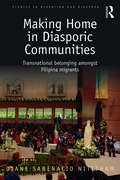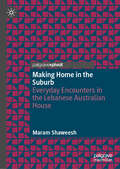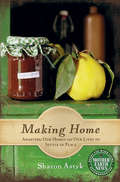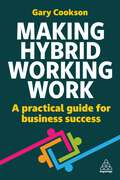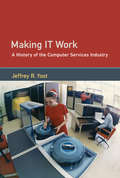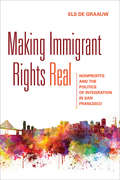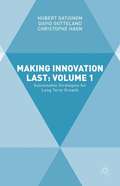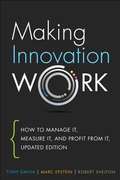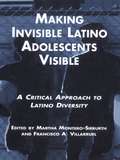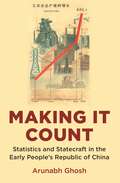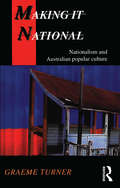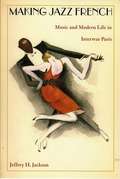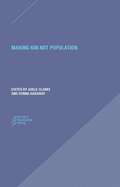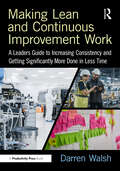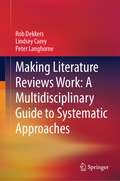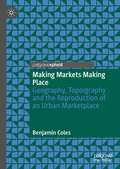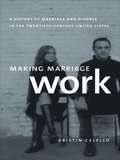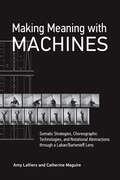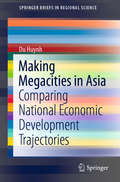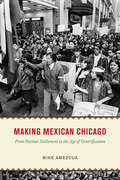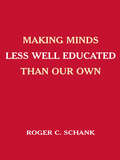- Table View
- List View
Making Home in Diasporic Communities: Transnational belonging amongst Filipina migrants (Studies in Migration and Diaspora)
by Diane Sabenacio NitithamMaking Home in Diasporic Communities demonstrates the global scope of the Filipino diaspora, engaging wider scholarship on globalisation and the ways in which the dynamics of nation-state institutions, labour migration and social relationships intersect for transnational communities. Based on original ethnographic work conducted in Ireland and the Philippines, the book examines how Filipina diasporans socially and symbolically create a sense of ‘home’. On one hand, Filipinas can be seen as mobile, as they have crossed geographical borders and are physically located in the destination country. Yet, on the other hand, they are constrained by immigration policies, linguistic and cultural barriers and other social and cultural institutions. Through modalities of language, rituals and religion and food, the author examines the ways in which Filipinas orient their perceptions, expectations, practices and social spaces to ‘the homeland’, thus providing insight into larger questions of inclusion and exclusion for diasporic communities. By focusing on a range of Filipina experiences, including that of nurses, international students, religious workers and personal assistants, Making Home in Diasporic Communities explores the intersectionality of gender, race, class and belonging. As such, it will appeal to scholars of sociology and anthropology as well as those with interests in gender, identity, migration, ethnic studies, and the construction of home.
Making Home in the Suburb: Everyday Encounters in the Lebanese Australian House
by Maram ShaweeshThis book investigates everyday life within Lebanese Australian homes, documenting how these homes integrate Lebanese Australian culture into suburban Australian life. It explores how the homemaking practices of Lebanese Australian families both influence and are influenced by the context of suburban housing in Australia. Drawing from in-depth interviews, household tours, photographic documentation, mental mapping, and historical imagery data collection, the book illuminates homemaking practices that have evolved from creating a "home away from home" to practices influenced by a unique Lebanese Australian lifestyle, rooted in the perception of Australia as their home.
Making Home: Adapting Our Homes and Our Lives to Settle in Place (Mother Earth News Books for Wiser Living)
by Sharon Astyk&“Shows us why the actions that prepare us for emergencies and energy descent are the right things to do no matter what the future brings.&” —Toby Hemenway, author of Gaia&’s Garden Other books tell us how to live the good life—but you might have to win the lottery to do it. Making Home is about improving life with the real people around us and the resources we already have. While encouraging us to be more resilient in the face of hard times, author Sharon Astyk also points out the beauty, grace, and elegance that result, because getting the most out of everything we use is a way of transforming our lives into something much more fulfilling. Written from the perspective of a family who has already made this transition, Making Home shows readers how to turn the challenge of living with less into settling for more—more happiness, more security, and more peace of mind. Learn simple but effective strategies to: · Save money on everything from heating and cooling to refrigeration, laundry, water, sanitation, cooking, and cleaning · Create a stronger, more resilient family · Preserve more for future generations We must make fundamental changes to our way of life in the face of ongoing economic crisis and energy depletion. Making Home takes the fear out of this prospect, and invites us to embrace a simpler, more abundant reality. &“Americans are born to be transient—Sharon Astyk has the prescription for dealing with that genetic disease, and building a healthy nativeness into our lives.&” —Bill McKibben, New York Times–bestselling author &“Exhaustively researched and compassionately delivered.&” —Harriet Fasenfest, author of A Householder&’s Guide to the Universe
Making Hybrid Working Work: A Practical Guide for Business Success
by Gary CooksonHybrid work is here to stay but we haven't got it right yet. To be truly effective, hybrid working must form part of the overall business strategy and work, organizational structures and teams must be designed with hybrid in mind. Making Hybrid Working Work is a practical book for senior business practitioners and people professionals wanting to ensure that hybrid working works for their people and their business. With guidance on leading, managing and developing hybrid workers, this book will help you embed hybrid working into your organization design. This book explores what hybrid means for your office real estate, how to choose the right technology for hybrid working and how to ensure you're only investing in automating the correct things. It discusses how to use data to take an evidence-based approach to solving problems in a hybrid organization and how you can support learning for hybrid workers, build a learning culture and prioritize performance, not location. With coverage of managing the hybrid employee experience with a focus on company culture, this book also includes the latest research, interviews with those who have experienced the benefits and challenges of this way of working and real-world examples from companies including Centrica, what3words and EMIS Health. Discover how to be deliberate about hybrid ways of working and not leave success to chance with this essential guide.
Making IT Work: A History of the Computer Services Industry (History of Computing)
by Jeffrey R. YostThe evolution of the multi-billion-dollar computer services industry, from consulting and programming to data analytics and cloud computing, with case studies of important companies.The computer services industry has worldwide annual revenues of nearly a trillion dollars and employs millions of workers, but is often overshadowed by the hardware and software products industries. In this book, Jeffrey Yost shows how computer services, from consulting and programming to data analytics and cloud computing, have played a crucial role in shaping information technology—in making IT work. Tracing the evolution of the computer services industry from the 1950s to the present, Yost provides case studies of important companies (including IBM, Hewlett Packard, Andersen/Accenture, EDS, Infosys, and others) and profiles of such influential leaders as John Diebold, Ross Perot, and Virginia Rometty. He offers a fundamental reinterpretation of IBM as a supplier of computer services rather than just a producer of hardware, exploring how IBM bundled services with hardware for many years before becoming service-centered in the 1990s.Yost describes the emergence of companies that offered consulting services, data processing, programming, and systems integration. He examines the development of industry-defining trade associations; facilities management and the firm that invented it, Ross Perot's EDS; time sharing, a precursor of the cloud; IBM's early computer services; and independent contractor brokerages. Finally, he explores developments since the 1980s: the transformations of IBM and Hewlett Packard; the offshoring of enterprises and labor; major Indian IT service providers and the changing geographical deployment of U.S.-based companies; and the paradigm-changing phenomenon of cloud service.
Making Immigrant Rights Real: Nonprofits and the Politics of Integration in San Francisco
by Els De GraauwMore than half of the 41 million foreign-born individuals in the United States today are noncitizens, half have difficulty with English, a quarter are undocumented, and many are poor. As a result, most immigrants have few opportunities to make their voices heard in the political process. Nonprofits in many cities have stepped into this gap to promote the integration of disadvantaged immigrants. They have done so despite notable constraints on their political activities, including limits on their lobbying and partisan electioneering, limited organizational resources, and dependence on government funding. Immigrant rights advocates also operate in a national context focused on immigration enforcement rather than immigrant integration. In Making Immigrant Rights Real, Els de Graauw examines how immigrant-serving nonprofits can make impressive policy gains despite these limitations.Drawing on three case studies of immigrant rights policies--language access, labor rights, and municipal ID cards--in San Francisco, de Graauw develops a tripartite model of advocacy strategies that nonprofits have used to propose, enact, and implement immigrant-friendly policies: administrative advocacy, cross-sectoral and cross-organizational collaborations, and strategic issue framing. The inventive development and deployment of these strategies enabled immigrant-serving nonprofits in San Francisco to secure some remarkable new immigrant rights victories, and de Graauw explores how other cities can learn from their experiences.
Making Innovation Last: Sustainable Strategies For Long Term Growth
by Hubert Gatignon David Gotteland Christophe HaonMaking Innovation Last considers the long term success of a firm. Authored by a trio of top international scholars who present pioneering new work on what it takes to create long term growth, the book examines the internal conditions that are likely to encourage sustainable innovation, as well as what a culture of innovation should look like.
Making Innovation Last: Sustainable Strategies for Long Term Growth
by Hubert Gatignon David Gotteland Christophe HaonMaking Innovation Last considers the long term success of a firm. Authored by a trio of top international scholars who present pioneering new work on what it takes to create long term growth, the book examines the internal conditions that are likely to encourage sustainable innovation, as well as what a culture of innovation should look like.
Making Innovation Work: How To Manage It, Measure It, And Profit From It, Updated Edition
by Tony Davila Marc Epstein Robert SheltonProfitable innovation doesn’t just happen. It must be managed, measured, and properly executed, and few companies know how to accomplish this effectively. Making Innovation Work presents a formal innovation process proven to work at HP, Microsoft and Toyota, to help ordinary managers drive top and bottom line growth from innovation. The authors have drawn on their unsurpassed innovation consulting experience -- as well as the most thorough review of innovation research ever performed. They'll show what works, what doesn't, and how to use management tools to dramatically increase the payoff from innovation investments. Learn how to define the right strategy for effective innovation; how to structure an organization to innovate best; how to implement management systems to assess ongoing innovation; how to incentivize teams to deliver, and much more. This book offers the first authoritative guide to using metrics at every step of the innovation process -- from idea creation and selection through prototyping and commercialization. This updated edition refreshes the examples used throughout the book and features a new introduction that gives currency to the principles covered throughout.
Making Invisible Latino Adolescents Visible: A Critical Approach to Latino Diversity (MSU Series on Children, Youth and Families #Vol. 1103)
by Martha Montero-Sieburth Francisco VillaruelFirst Published in 2000. Routledge is an imprint of Taylor & Francis, an informa company.
Making It All Work: Winning at the Game of Work and the Business of Life
by David AllenDavid Allen's Getting Things Done hit a nerve and ignited a movement with businesses, students, soccer moms, and techies all the way from Silicon Valley to Europe and Asia. Now, David Allen leads the world on a new path to achieve focus, control, and perspective. Throw out everything you know about productivity - Making It All Work will make life and work a game you can win. For those who have already experienced the clarity of mind from reading Getting Things Done, Making It All Work will take the process to the next level. David Allen shows us how to excel in dealing with our daily commitments, the unexpected, and the information overload that threatens to drown us. Making It All Work provides an instantly usable, success-building tool kit for staying ahead of the game. Making It All Work addresses: how to figure out where you are in life and what you need; how to be your own consultant and a CEO of your life; moving from hope to trust in decision-making; when not to set goals; harnessing intuition, spontaneity, and serendipity; and why life is like business and business is like life.
Making It Count: Statistics and Statecraft in the Early People's Republic of China (Histories of Economic Life #23)
by Arunabh GhoshA history of how Chinese officials used statistics to define a new society in the early years of the People’s Republic of China In 1949, at the end of a long period of wars, one of the biggest challenges facing leaders of the new People’s Republic of China was how much they did not know. The government of one of the world’s largest nations was committed to fundamentally reengineering its society and economy via socialist planning while having almost no reliable statistical data about their own country. Making It Count is the history of efforts to resolve this “crisis in counting.” Drawing on a wealth of sources culled from China, India, and the United States, Arunabh Ghosh explores the choices made by political leaders, statisticians, academics, statistical workers, and even literary figures in attempts to know the nation through numbers.Ghosh shows that early reliance on Soviet-inspired methods of exhaustive enumeration became increasingly untenable in China by the mid-1950s. Unprecedented and unexpected exchanges with Indian statisticians followed, as the Chinese sought to learn about the then-exciting new technology of random sampling. These developments were overtaken by the tumult of the Great Leap Forward (1958–61), when probabilistic and exhaustive methods were rejected and statistics was refashioned into an ethnographic enterprise. By acknowledging Soviet and Indian influences, Ghosh not only revises existing models of Cold War science but also globalizes wider developments in the history of statistics and data.Anchored in debates about statistics and its relationship to state building, Making It Count offers fresh perspectives on China’s transition to socialism.
Making It National: Nationalism and Australian popular culture
by Graeme TurnerMaking it National argues that we need to rethink the way national identity is constructed in Australia today. Graeme Turner takes a series of recent instances - the mythologising of Bond and the larrikin entrepreneurs, the Spycatcher trials, Maralinga and the Bicentenary - showing how popular images of national identity are used to serve specific rather than national interests.'Graeme Turner's writing has a remarkable power to engage its readers with all the immediacy, vividness and drama of our very best journalism, while putting cultural theory to work in new and creative ways.' - Meaghan Morris'Making it National could be to the 1990s what Richard White's Inventing Australia was to the 1980s.' - Tony Bennett, Institute for Cultural Policy Studies, Griffith University
Making Jazz French: Music and Modern Life in Interwar Paris
by Jeffrey H. JacksonBetween the world wars, Paris welcomed not only a number of glamorous American expatriates, including Josephine Baker and F. Scott Fitzgerald, but also a dynamic musical style emerging in the United States: jazz. Roaring through cabarets, music halls, and dance clubs, the upbeat, syncopated rhythms of jazz soon added to the allure of Paris as a center of international nightlife and cutting-edge modern culture. In Making Jazz French, Jeffrey H. Jackson examines not only how and why jazz became so widely performed in Paris during the 1920s and 1930s but also why it was so controversial. Drawing on memoirs, press accounts, and cultural criticism, Jackson uses the history of jazz in Paris to illuminate the challenges confounding French national identity during the interwar years. As he explains, many French people initially regarded jazz as alien because of its associations with America and Africa. Some reveled in its explosive energy and the exoticism of its racial connotations, while others saw it as a dangerous reversal of France's most cherished notions of "civilization. " At the same time, many French musicians, though not threatened by jazz as a musical style, feared their jobs would vanish with the arrival of American performers. By the 1930s, however, a core group of French fans, critics, and musicians had incorporated jazz into the French entertainment tradition. Today it is an integral part of Parisian musical performance. In showing how jazz became French, Jackson reveals some of the ways a musical form created in the United States became an international phenomenon and acquired new meanings unique to the places where it was heard and performed.
Making Kin Not Population
by Donna Haraway Adele E. Clarke<p>As the planet’s human numbers grow and environmental concerns proliferate, natural scientists, economists, and policy-makers are increasingly turning to new and old questions about families and kinship as matters of concern. From government programs designed to fight declining birth rates in Europe and East Asia, to controversial policies seeking to curb population growth in countries where birth rates remain high, to increasing income inequality transnationally, issues of reproduction introduce new and complicated moral and political quandaries. <p>Making Kin Not Population ends the silence on these issues with essays from leading anti-racist, ecologically-concerned, feminist scholars. Though not always in accord, these contributors provide bold analyses of complex issues of intimacy and kinship, from reproductive justice to environmental justice, and from human and nonhuman genocides to new practices for making families and kin. This timely work offers vital proposals for forging innovative personal and public connections in the contemporary world.</p>
Making Lean and Continuous Improvement Work: A Leaders Guide to Increasing Consistency and Getting Significantly More Done in Less Time
by Darren WalshDespite the popularity of lean and continuous improvement around the world, most organisations and their leaders struggle to make improvement work. Many are trying to cope with day-to-day business issues. They bury their heads in the work as they either give up on trying to improve or are floundering as they keep trying new initiatives to improve with little success. Most lean thinking and improvement publications focus on the use of improvement tools but never really get to the core of why organisations are not seeing the real results from these techniques and lean thinking as an improvement strategy. They talk about what to do but not about the common problems you can expect along the way and how to navigate these and create a fundamental change in how the business works. Making Lean and Continuous Improvement Work will help solve this problem and help leaders build a solid foundation to making lean and continuous improvement work in their business. Through numerous examples and detailed case studies, the book shows how business leaders, managers and frontline supervisors can make lean and continuous improvement techniques work, increasing consistency and getting more work done, in less time.
Making Literature Reviews Work: A Multidisciplinary Guide to Systematic Approaches
by Peter Langhorne Rob Dekkers Lindsey CareyThis textbook guides the reader on how to undertake high-quality literature reviews, from traditional narrative to protocol-driven reviews. The guidance covers a broad range of purposes, disciplines and research paradigms. Whether the literature review is part of a research project, doctoral study, dissertation or a stand-alone study, the book offers approaches, methods, tools, tips and guidelines to produce more effective literature reviews in an efficient manner. The numerous examples are drawn from an array of subject areas, such as economics, healthcare, education, medicine, psychology, software engineering amongst others. This makes it worthwhile for a wide range of studies and for reviews into evidence-based interventions, policies, practices and treatments. There is attention given to presenting, reporting and publishing literature reviews. With the additional clarity brought about by explanatory tables and graphs, this textbook is a ‘must-have’ for all students, researchers, academics and practitioners at any stage of their project or career when engaging with literature. In addition, citizens, policymakers and practitioners will benefit from the guidance with better insight into how literature reviews could and should have been conducted.
Making Los Angeles Home: The Integration of Mexican Immigrants in the United States
by Rafael Alarcón Luis Escala Olga OdgersMaking Los Angeles Home examines the different integration strategies implemented by Mexican immigrants in the Los Angeles region. Relying on statistical data and ethnographic information, the authors analyze four different dimensions of the immigrant integration process (economic, social, cultural, and political) and show that there is no single path for its achievement, but instead an array of strategies that yield different results. However, their analysis also shows that immigrants' successful integration essentially depends upon their legal status and long residence in the region. The book shows that, despite this finding, immigrants nevertheless decide to settle in Los Angeles, the place where they have made their homes.
Making Markets Making Place: Geography, Topo/graphy and the Reproduction of an Urban Marketplace
by Benjamin ColesThis book examines place and place-making in London’s Borough Market. In particular, it uses topo/graphy (‘place-writing) to interrogate the ways in which Borough Market’s material, social-sensual and discursive relations assemble to reproduce Borough Market as a place, market and marketplace. Its central premise is that market-processes – the negotiation and exchange of commodities –are place-processes. This means that the often-abstract relationships that ultimately define what we think of as the economy are embedded in the rich and every materiality, sociality, sensuality and meanings associated with place. By tracing out these different elements, topo/graphy illustrates the ways in which economic reproduction is grounded in particular and often discrete practices. However, by assembling them together, this highlights the ways in which place and place-making are the driving force behind the economy at large.
Making Marriage Work: A History of Marriage and Divorce in the Twentieth-Century United States
by Kristin CelelloBy the end of World War I, the skyrocketing divorce rate in the United States had generated a deep-seated anxiety about marriage. This fear drove middle-class couples to seek advice, both professional and popular, in order to strengthen their relationships. InMaking Marriage Work, historian Kristin Celello offers an insightful and wide-ranging account of marriage and divorce in America in the twentieth century, focusing on the development of the idea of marriage as "work. " Examining the marriage counseling profession, advice columns in women's magazines, movies, and television shows, Celello describes how professionals and the public worked together to define the nature of marital work throughout the twentieth century. She also demonstrates that the maxim of "working at marriage" often masked important inequalities in regard to men's and women's roles within marriage. Most experts, for instance, assumed that women needed marriage more than men and thus held wives accountable for marital success or failure. Making Marriage Workpresents a new interpretation of married life in the United States, illuminating the interaction of marriage and divorce over the century and revealing how the idea that marriage requires work became part of Americans' collective consciousness.
Making Meaning with Machines: Somatic Strategies, Choreographic Technologies, and Notational Abstractions through a Laban/Bartenieff Lens
by Amy LaViers Catherine MaguireA rigorous primer in movement studies for designers, engineers, and scientists that draws on the fields of dance and robotics.How should a gestural interface react to a &“flick&” versus a &“dab&”? Versus a &“punch&”? Should robots reach out to a human counterpart with a direct, telescoping action or through a circuitous arc in space? Just as different movements express the different internal states of human movers, so too can the engineered systems behind robots. In Making Meaning with Machines, Amy LaViers and Catherine Maguire offer a refreshingly embodied approach to machine design that supports the growing need to make meaning with machines by using the field of movement studies, including choreography, somatics, and notation, to engage in the process of designing expressive robots.Drawing upon the Laban/Bartenieff tradition, LaViers and Maguire sharpen the movement analysis methodology, expanding the material through their work with machines and putting forward new conventions, such as capitalization, naming, and notation schemes, that make the embodied work more legible for academic contexts. The book includes an overview of movement studies, exercises that define the presented taxonomy and principles of movement, case studies in movement analysis of both humans and robots, and state-of-the-art research at the intersection of robotics and dance.Making Meaning with Machines is a much-needed primer for observing, describing, and creating a wide array of movement patterns, which ultimately can help facilitate broader and better design choices for roboticists, technologists, and designers.
Making Megacities in Asia: Comparing National Economic Development Trajectories (SpringerBriefs in Regional Science)
by Du HuynhThis book analyses and compares the development paths of five major cities in East and Southeast Asia since the early 1960s, including Ho Chi Minh City, Jakarta, Manila, Seoul, and Shanghai. In examining these five cases through a carefully crafted conceptual framework, the author excavates an understanding of the dynamics that have enabled Seoul and Shanghai to become highly competitive as major engines of economic growth, while simultaneously accounting for why the other three cities have faced numerous problems in terms of meeting their development goals. Presenting both quantitative and qualitative data to trace the course of changes between 1960 and 2015, the case studies curate six possible explanations for the different cities’ developmental trajectories. The book considers the national development strategy matters to the development of cities and positions the share of budget revenue retained for cities’ expenditure as critical. The author demonstrates that consistently pursuing long-term strategies is important, and that public entrepreneurship with powerful supporting coalitions is vital. The book illustrates how master plans have played limited roles in the building of cities, and that fragmented governments are often at the root of the problems facing a city’s development. This book will be highly relevant to researchers in international and Asian urban development.
Making Mexican Chicago: From Postwar Settlement to the Age of Gentrification (Historical Studies of Urban America)
by Mike AmezcuaAn exploration of how the Windy City became a postwar Latinx metropolis in the face of white resistance. Though Chicago is often popularly defined by its Polish, Black, and Irish populations, Cook County is home to the third-largest Mexican-American population in the United States. The story of Mexican immigration and integration into the city is one of complex political struggles, deeply entwined with issues of housing and neighborhood control. In Making Mexican Chicago, Mike Amezcua explores how the Windy City became a Latinx metropolis in the second half of the twentieth century. In the decades after World War II, working-class Chicago neighborhoods like Pilsen and Little Village became sites of upheaval and renewal as Mexican Americans attempted to build new communities in the face of white resistance that cast them as perpetual aliens. Amezcua charts the diverse strategies used by Mexican Chicagoans to fight the forces of segregation, economic predation, and gentrification, focusing on how unlikely combinations of social conservatism and real estate market savvy paved new paths for Latinx assimilation. Making Mexican Chicago offers a powerful multiracial history of Chicago that sheds new light on the origins and endurance of urban inequality.
Making Mexican Chicago: From Postwar Settlement to the Age of Gentrification (Historical Studies of Urban America)
by Mike AmezcuaAn exploration of how the Windy City became a postwar Latinx metropolis in the face of white resistance. Though Chicago is often popularly defined by its Polish, Black, and Irish populations, Cook County is home to the third-largest Mexican-American population in the United States. The story of Mexican immigration and integration into the city is one of complex political struggles, deeply entwined with issues of housing and neighborhood control. In Making Mexican Chicago, Mike Amezcua explores how the Windy City became a Latinx metropolis in the second half of the twentieth century. In the decades after World War II, working-class Chicago neighborhoods like Pilsen and Little Village became sites of upheaval and renewal as Mexican Americans attempted to build new communities in the face of white resistance that cast them as perpetual aliens. Amezcua charts the diverse strategies used by Mexican Chicagoans to fight the forces of segregation, economic predation, and gentrification, focusing on how unlikely combinations of social conservatism and real estate market savvy paved new paths for Latinx assimilation. Making Mexican Chicago offers a powerful multiracial history of Chicago that sheds new light on the origins and endurance of urban inequality.
Making Minds Less Well Educated Than Our Own
by Roger C. SchankIn the author's words: "This book is an honest attempt to understand what it means to be educated in today's world." His argument is this: No matter how important science and technology seem to industry or government or indeed to the daily life of people, as a society we believe that those educated in literature, history, and other humanities are in some way better informed, more knowing, and somehow more worthy of the descriptor "well educated." This 19th-century conception of the educated mind weighs heavily on our notions on how we educate our young. When we focus on intellectual and scholarly issues in high school as opposed to issues, such as communications, basic psychology, or child raising, we are continuing to rely on outdated notions of the educated mind that come from elitist notions of who is to be educated and what that means. To accommodate the realities of today's world it is necessary to change these elitist notions. We need to rethink what it means to be educated and begin to focus on a new conception of the very idea of education. Students need to learn how to think, not how to accomplish tasks, such as passing standardized tests and reciting rote facts. In this engaging book, Roger C. Schank sets forth the premises of his argument, cites its foundations in the Great Books themselves, and illustrates it with examples from an experimental curriculum that has been used in graduate schools and with K-12 students. Making Minds Less Well Educated Than Our Own is essential reading for scholars and students in the learning sciences, instructional design, curriculum theory and planning, educational policy, school reform, philosophy of education, higher education, and anyone interested in what it means to be educated in today's world.
